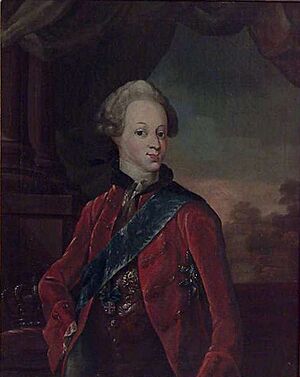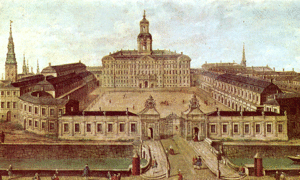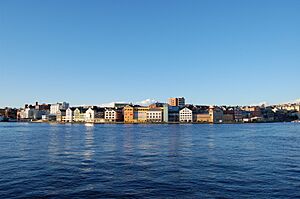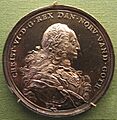Christian VI of Denmark facts for kids
Quick facts for kids Christian VI |
|
|---|---|
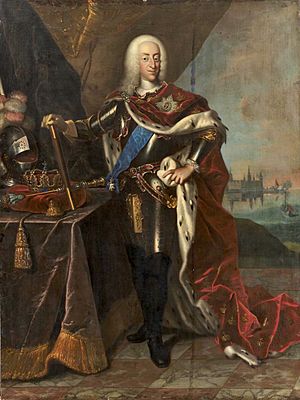
Portrait of Christian VI by Johann Salomon Wahl
|
|
| King of Denmark and Norway (more...) | |
| Reign | 12 October 1730 – 6 August 1746 |
| Coronation | 6 June 1731 Frederiksborg Palace Chapel |
| Predecessor | Frederick IV |
| Successor | Frederick V |
| Chief Ministers |
See list
Iver Rosenkrantz
Johan Ludvig Holstein |
| Born | 30 November 1699 Copenhagen Castle |
| Died | 6 August 1746 (aged 46) Hirschholm Palace, Copenhagen |
| Burial | Roskilde Cathedral, Zealand |
| Spouse | Sophie Magdalene of Brandenburg-Kulmbach (m. 1721) |
| Issue | Frederick V of Denmark Louise, Duchess of Saxe-Hildburghausen |
| House | Oldenburg |
| Father | Frederick IV of Denmark |
| Mother | Louise of Mecklenburg-Güstrow |
| Religion | Lutheran |
Christian VI (born 30 November 1699 – died 6 August 1746) was the King of Denmark and Norway from 1730 to 1746. He was the oldest son of King Frederick IV of Denmark and Queen Louise of Mecklenburg-Güstrow.
Christian VI was known for being a very serious and religious king. He was the first king from the Oldenburg family who did not go to war. During his time as king, two important things happened: everyone had to be confirmed in the church (1736), and a public school system was started across the country (1739). His motto was "Deo et populo", which means "for God and the people".
Contents
Becoming King: Christian VI's Early Life
Christian was born on 30 November 1699 at Copenhagen Castle. He was the second son, but the oldest to survive, of King Frederick IV and Queen Louise. His grandfather, King Christian V, had died just three months before Christian VI was born. This meant Christian was the crown prince from the day he was born.
From 1706, Christian learned to understand Danish. However, he mostly spoke and wrote in German. He had a much better education than his father and grandfather.
Finding a Queen: Christian VI's Marriage
As a young prince, his father allowed him to choose his own wife. Christian traveled around Europe. He met Sophie Magdalene of Brandenburg-Kulmbach. She was one of the ladies-in-waiting at a royal court in Germany.
Sophie Magdalene came from a small, less wealthy family. She had 13 brothers and sisters. Many people thought she was not a good match for a Danish prince. But the king gave his permission. Christian wrote in his letters that he liked her strong religious beliefs. They were married on 7 August 1721. The wedding took place in Saxony, Germany.
Christian VI's Time as King
When his father, Frederick IV, died on 12 October 1730, Christian and Sophie Magdalene became the King and Queen of Denmark-Norway. They had their coronation ceremony on 6 June 1731. This took place in the Chapel of Frederiksborg Palace.
The king was a shy person and preferred to stay away from public events. For the first ten years of his rule, he often asked for advice from his cousin, Count Christian Ernst of Stolberg-Wernigerode. The count helped the king with many things. He even helped arrange the marriage between Christian's son, Frederick V, and Louise of Great Britain, who was the daughter of the British King George II.

In 1733, the king and queen traveled to Norway. A special poem was read to honor him when he visited the city of Trondheim.
New Laws and Changes in Denmark
One of Christian's most important laws was the adscription of 1733. This law made farmers stay in their home regions. It also meant that farmers had to serve the local nobles and the army. The idea was to make sure there were always enough soldiers. However, many people later saw this law as very unfair to the farmers. It was removed in 1788.
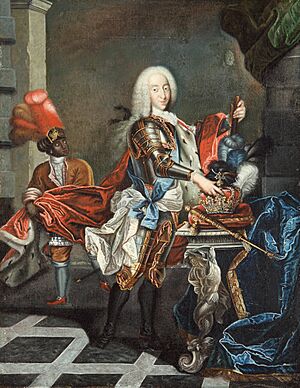
King Christian was very religious, following a strict form of Protestantism called Pietism. His strong beliefs influenced many of his decisions about the church. Even though some nobles and common people did not like his strict religious rules, they had a big effect.
One lasting result was the introduction of mandatory confirmation in 1736. This meant that young people had to learn to read to be confirmed. This led to the need for a public school system. So, in 1739, a new law created schools for everyone.
Building Grand Palaces
King Christian VI was a very active builder. He built more grand buildings than almost any other Danish king in the 1700s. His queen also helped a lot with these projects.
Some of their famous buildings include:
- Christiansborg Palace: Built from 1732 to 1742. It later burned down in 1794 but was rebuilt.
- Hirschholm Palace: A summer home in North Zealand, built from 1737 to 1739. It was later taken down in 1812.
- The Eremitage: Built from 1734 to 1736, and it is still standing today.
They also built the Prince's Palace for their son, Crown Prince Frederik (V). This palace was built from 1743 to 1744 and is now the National Museum.
These expensive buildings were paid for by the Sound Dues, which were taxes on ships passing through the Øresund strait. The palaces were meant to show the power and wealth of Denmark. However, they also put a heavy financial burden on the people.
Peaceful Foreign Policy
Christian VI believed in peace. Denmark-Norway stayed completely neutral during his reign. This means they did not take sides in any wars. This was a time of growth for trade and business. New companies and banks were started.
Christian had hoped that his only daughter, Princess Louise, would become the Queen of Sweden. But this plan did not work out. In 1743, Adolf Frederik of Holstein-Gottorp was chosen as the next king of Sweden instead.
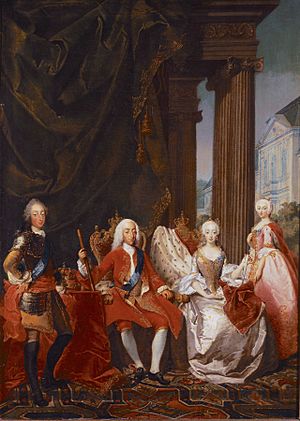
Death and Legacy
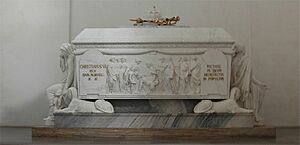
Christian VI was often sick throughout his life. He died on 6 August 1746 at Hirschholm Palace. This was just one day before his 25th wedding anniversary.
Christian VI was buried in Roskilde Cathedral. His wife, the queen, asked the sculptor Johannes Wiedewelt to design a special monument for him. This monument was finished in 1768. It was placed in Roskilde Cathedral in 1777. The monument includes a large stone coffin (sarcophagus) and two female figures. These figures represent "Sorrow" and "Fame". This was the first monument in Denmark made in the neoclassical style. It marked the beginning of this art style in the country.
What Christian VI is Remembered For
Christian VI is mostly remembered as a very religious ruler. He tried to make all his people follow the strict teachings of Pietism. Because of his strong religious rules and his shy personality, he was not one of the most popular kings. However, he was the first king who kept Denmark-Norway out of all wars.
Two cities are named after him: Kristiansund in Norway and Christiansted on Saint Croix.
Ancestry
| Ancestors of Christian VI of Denmark | |||||||||||||||||||||||||||||||||||||||||||||||||||||||||||||||||||||||||||||||||||||||||||||||||||||||||||||||||||||||||||||||||||||||||||||||||||||||||||||||||||||||||||||||||||||||||||||||||||||||||||||||||||||||||||||||||||||||||||||||||||||||||||||||||||||||||||||||||||||||||
|---|---|---|---|---|---|---|---|---|---|---|---|---|---|---|---|---|---|---|---|---|---|---|---|---|---|---|---|---|---|---|---|---|---|---|---|---|---|---|---|---|---|---|---|---|---|---|---|---|---|---|---|---|---|---|---|---|---|---|---|---|---|---|---|---|---|---|---|---|---|---|---|---|---|---|---|---|---|---|---|---|---|---|---|---|---|---|---|---|---|---|---|---|---|---|---|---|---|---|---|---|---|---|---|---|---|---|---|---|---|---|---|---|---|---|---|---|---|---|---|---|---|---|---|---|---|---|---|---|---|---|---|---|---|---|---|---|---|---|---|---|---|---|---|---|---|---|---|---|---|---|---|---|---|---|---|---|---|---|---|---|---|---|---|---|---|---|---|---|---|---|---|---|---|---|---|---|---|---|---|---|---|---|---|---|---|---|---|---|---|---|---|---|---|---|---|---|---|---|---|---|---|---|---|---|---|---|---|---|---|---|---|---|---|---|---|---|---|---|---|---|---|---|---|---|---|---|---|---|---|---|---|---|---|---|---|---|---|---|---|---|---|---|---|---|---|---|---|---|---|---|---|---|---|---|---|---|---|---|---|---|---|---|---|---|---|---|---|---|---|---|---|---|---|---|---|---|---|---|---|---|---|
|
|||||||||||||||||||||||||||||||||||||||||||||||||||||||||||||||||||||||||||||||||||||||||||||||||||||||||||||||||||||||||||||||||||||||||||||||||||||||||||||||||||||||||||||||||||||||||||||||||||||||||||||||||||||||||||||||||||||||||||||||||||||||||||||||||||||||||||||||||||||||||
Images for kids
See also
 In Spanish: Cristián VI de Dinamarca para niños
In Spanish: Cristián VI de Dinamarca para niños


